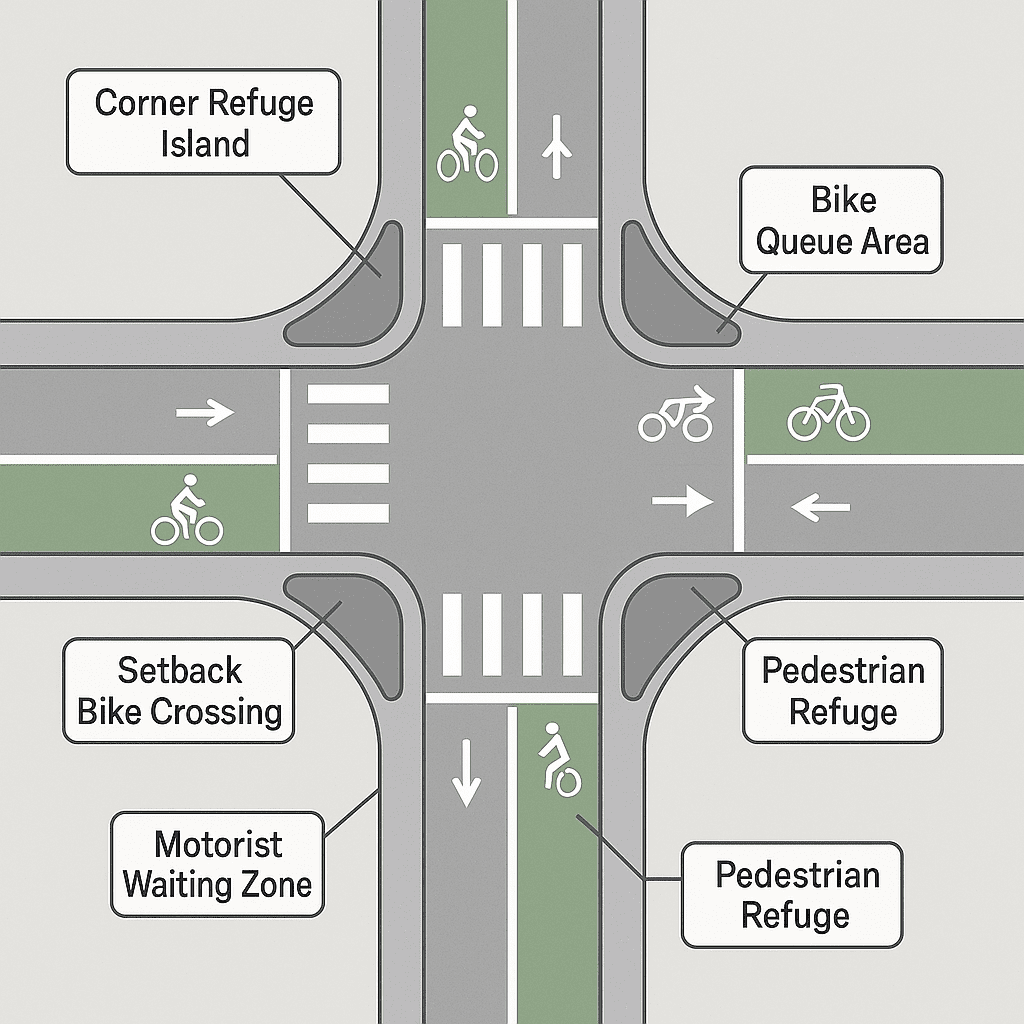Dutch-Style Protected Intersections: Safeguarding Cyclists & Pedestrians

Core Design Elements
Dutch-style intersections combine physical and operational features to prioritize safety without sacrificing efficiency. Each element reduces conflicts and enhances visibility.| Element | How It Works | Safety Benefit |
|---|---|---|
| Corner refuge / leading island | Curb extensions tighten the turn radius and create a protected waiting area for bikes. | Slows turning vehicles and positions drivers to look toward crossing users rather than over their shoulders. |
| Set-back (“bend-out”) crossings | Bike and walk crossings are pulled ≈ 20–25 ft back from the intersection. | Improves sightlines and provides reaction time, reducing right-hook collisions. |
| Bike queue / forward stop bar | Cyclists wait ahead of the vehicle stop line. | Keeps riders visible in drivers’ direct line of sight when the light turns green. |
| Motorist waiting / yield zone | Space between the car stop bar and bike crossing where turning drivers yield. | Encourages full stops and yielding before crossing bike and pedestrian space. |
| Dedicated signal phasing or leading-bike interval | Separate or early green for cyclists and pedestrians. | Eliminates simultaneous, conflicting movements with turning cars. |
Did You Know? Dutch-style intersections can reduce right-hook collisions by up to 70% in urban settings.
Why It Protects Cyclists
- Higher yielding rates – Field studies in U.S. pilot installations show drivers yield more frequently when crossings are set back and clearly marked.
- Slower turning speeds – A tighter curb radius can trim right-turn speeds by 2–3 mph, greatly reducing crash severity.
- Predictable paths – Two-stage left turns and continuous greens keep riders within protected space the entire way.
Why It Protects Pedestrians
- Shorter, staged crossings – Refuge islands split the crossing into two manageable segments, so pedestrians face only one traffic stream at a time.
- Improved visibility – Set-back crosswalks place pedestrians squarely in a driver’s forward field of view before the vehicle begins its turn.
- Better compliance – Clear yield zones paired with pedestrian signals boost driver yielding and decrease violation rates.
Adoption in North America
Since debuting in Davis, CA and Salt Lake City, UT (2015-2016), Dutch-style intersections have spread to cities like Portland, OR, and Austin, TX, where crash rates dropped by up to 30%. Many cities now include them in Vision Zero action plans, supported by NACTO and FHWA design guides with detailed geometry and signal-timing standards.Challenges and Solutions
Retrofitting Dutch-style intersections in dense urban areas can be costly and space-intensive. However, cities like Seattle have used modular designs and phased implementations to adapt these layouts to constrained spaces, proving their versatility.Takeaway
By forcing slower turns, giving vulnerable users a head start, and maximizing sightlines, Dutch-style intersections turn dangerous crossings into safe, accessible spaces—encouraging more people to walk and ride. Check your city’s Vision Zero plan to advocate for these designs!References
- NACTO, Urban Bikeway Design Guide, 2020.
- FHWA, Protected Intersection Design Guidelines, 2023.

